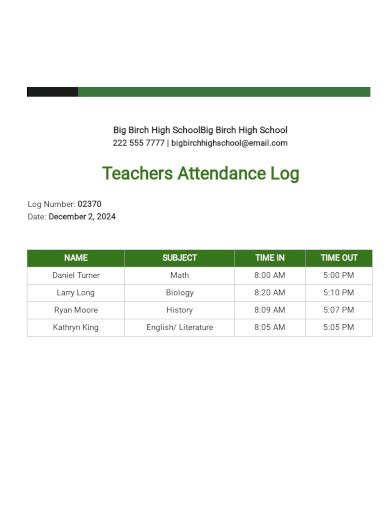12+ Sample Attendance Log
-

Free Attendance Log Template
download now -

Daycare Attendance Log Template
download now -

Teachers Attendance Log
download now -

Student Attendance Log Template
download now -

Yearly Attendance Log Template
download now -

Sample Attendance Log
download now -

Sample Falls Attendance Log
download now -

Activity Attendance Log
download now -

Sample Student Attendance Log
download now -

Sample Volunteer Attendance Log
download now -

Program Attendance Verification Log
download now -

Field Experience Attendance Log
download now -

Sample Application Attendance Log
download now
FREE Attendance Log s to Download
12+ Sample Attendance Log
What is Sample Attendance Log?
How do I Create an Attendance Log?
What Information should be in an Attendance Log?
Why is an Attendance Log Important?
How often should I update the Attendance Log?
Is a signature required in the Attendance Log?
How should I secure a digital Attendance Log?
What is Sample Attendance Log?
A Sample Attendance Log is a comprehensive record-keeping tool designed to track and manage attendance in various settings, such as businesses, schools, or events. It serves as a reliable method for monitoring the presence or absence of individuals over a specific period. The log typically includes details like names, dates, and timestamps.
You May Also See SAMPLE Tracking Logs
Benefits of using a Sample Attendance Log include:
1. Accurate Record-Keeping: Maintain a precise record of attendance for individuals, making it easy to reference and analyze attendance patterns.
2. Efficiency: Streamline the attendance tracking process, saving time and effort compared to manual methods.
3. Punctuality Monitoring: Identify trends in punctuality and attendance to address any issues promptly.
4. Compliance: Ensure adherence to attendance policies and regulatory requirements.
5. Event Management: Facilitate smooth coordination of events by keeping track of participant attendance.
How do I Create an Attendance Log?
To create an Attendance Log:
1. Open a tracking spreadsheet program like Excel.
2. Create columns for essential information: Date, Name, Time In, Time Out (if applicable).
3. Customize with additional columns as needed (e.g., department, course).
4. Decide on a tracking method (manual entry, digital system, barcode scanning).
5. Regularly update the log immediately after attendance list is taken.
6. Consider digital options for efficiency.
7. Review and analyze attendance data periodically.
8. Implement security measures for digital logs.
9. Use a consistent date format for clarity.
10. Backup digital logs regularly and ensure secure storage.
What Information should be in an Attendance Log?
An Attendance Log should include the following essential information:
1. Date: The date when attendance is recorded.
2. Name: The names of individuals for whom attendance is being tracked.
3. Time In: The time when individuals arrive or start their activity.
4. Time Out: If applicable, the time when individuals leave or end their activity.
Additional information may be included based on your specific needs:
1. Department: Specify the department or group to which individuals belong.
2. Course: If applicable, note the course or program in an educational setting.
3. Signature/Verification: Provide space for signatures or verification, depending on the context.
You May Also See SAMPLE Time Logs
Why is an Attendance Log Important?
An Attendance Log is important for several reasons:
1. Accurate Record-Keeping: It serves as a reliable and organized method to record and track attendance, providing an accurate historical account.
2. Punctuality Monitoring: Helps in monitoring and addressing issues related to punctuality, identifying trends, and ensuring adherence to schedules.
3. Compliance: Essential for compliance with organizational policies, regulatory requirements, or legal standards related to attendance.
4. Efficiency: Streamlines the process of tracking attendance, saving time and effort compared to manual methods, especially in larger organizations.
5. Event Management: Facilitates the smooth coordination of events by accurately tracking the attendance of participants.
6. Decision-Making: Provides valuable data for decision-making processes related to resource allocation, staffing, and other organizational considerations.
7. Productivity Measurement: Aids in assessing productivity by understanding attendance patterns and identifying areas for improvement.
8. Accountability: Establishes a system of accountability, encouraging individuals to be responsible for their attendance and punctuality.
9. Performance Evaluation: In educational settings or work log, attendance logs may be used in performance evaluations and assessments.
10. Documentation: Creates a sample document history of attendance, which can be useful for audits, reviews, or future Documentation planning.
How often should I update the Attendance Log?
Update the Attendance Log regularly, preferably immediately after attendance is taken, to ensure accuracy and reliability.
Is a signature required in the Attendance Log?
Depending on the context, you may include a space for signatures or verification to confirm the accuracy of recorded
attendance
How should I secure a digital Attendance Log?
Implement security measures for digital logs, including regular backups and secure storage, especially if containing sensitive information.
You May Also See SAMPLE Workout Logs
In conclusion, creating an Attendance Log is essential for accurate record-keeping, punctuality monitoring, and organizational efficiency. This guide provides a straightforward approach using spreadsheet tools, emphasizing customization based on specific needs. Regular updates, digital options for efficiency, and security measures ensure a reliable system. Effectively managing attendance is key to fostering accountability, compliance, and informed decision-making in various contexts.
